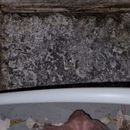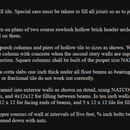Air sealing hollow structural clay tile along horizontal sill
Hopefully I am using the correct terminology below; first time homeowner, so still learning.
I have a 1920s house; Natco hollow structural clay tile with structurally bonded brick veneer on a poured concrete basement. I am in climate zone 5
I’m trying to air seal the basement and have a quandary, how do I air seal between the horizontal sections of the floor joists and the portion of clay tile on the basement sill?
I’ve done a lot of research on the history and building materials used in this particular house. Per the builders manuals, they used roofing cement to seal everything, including the sill plates, which is supposed to act as an air and vapor barrier. “Sills – Form all sills of NATCO special hollow sill tile. Special care must be taken to fill all joints so as to prevent moisture working through the same; wood sill of frame to be set in heavy bed of roofers cement.” I’m relatively confident that the house was built to the NATCO specifications due to the history of the area.
Some of that cement has deteriorated, creating an uneven gap that needs filled. I don’t want to disturb the intact cement as it most likely contains asbestos.
1. Does the 1920’s roofers cement actually work like an air and vapor barrier? If it is a air and vapor barrier, does that mean that section of the tile is cold?
2. I don’t have full access to the horizontal sections; can they be resealed using spray foam? Will the spray foam adhere to the floor joist and old roofers cement to create the air and vapor barrier that is called for in the builders manual?
3. I have full access to the box sills; should they be filled with a cement where the tile and the embedded floor joist is undamaged?
The basement is dry except on one side. Horizontal sections of the floor joists do not show evidence of water damage. I’m going to contact a mason with experience with this type of material for those areas that show damage.
Attached are screen shots from the builders manual as well as pictures of intact cement vs missing cement. I can upload the NATCO manual if it would be useful.
GBA Detail Library
A collection of one thousand construction details organized by climate and house part












Replies